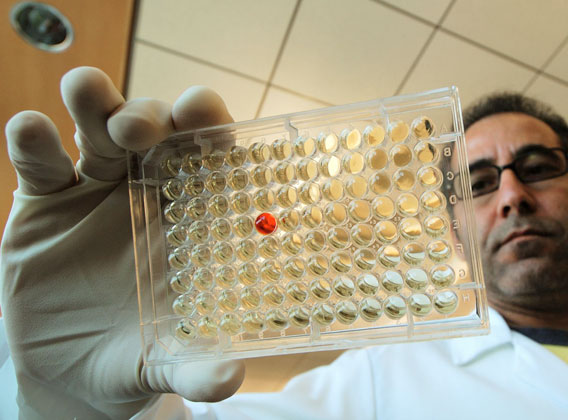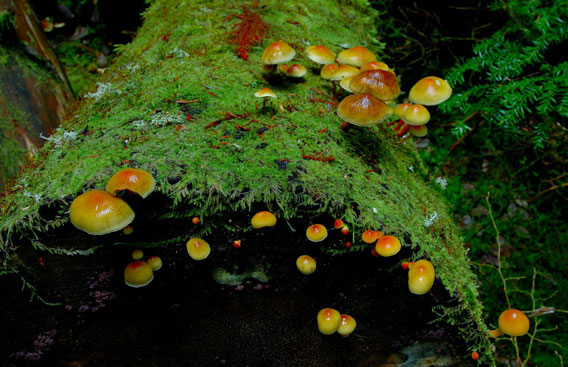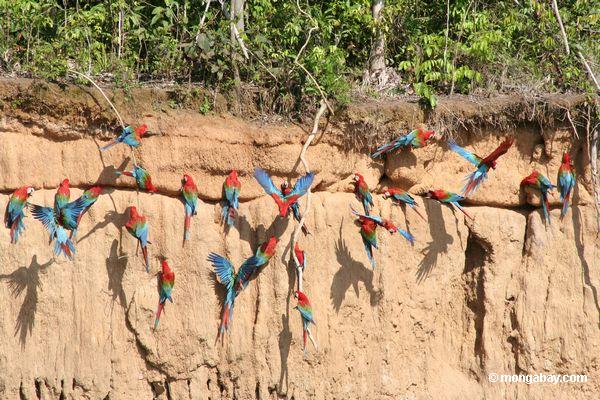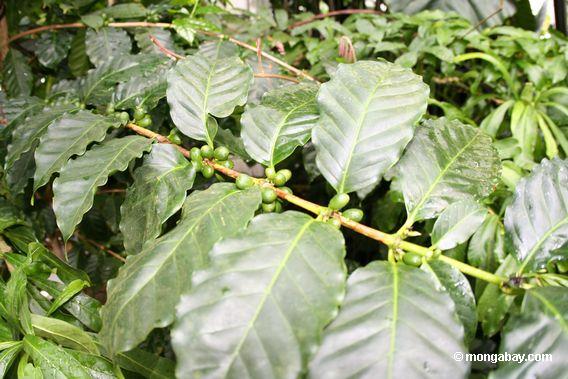Red-and-green macaws (Ara chloroptera) eating clay in order to aid digestion. Photo by: Rhett A. Butler.
As humans we take many things for granted. When we come down with a sore throat, a fever, or the dreaded stomach flu, we drag our aching bodies into our cars and visit the doctor. Animals have no such luxury. Instead they have mastered evolution and have acquired an innate knowledge of the plants, soils, minerals, algae, and other remedies that nature offers to heal their aches and pains.
Zoopharmacognosy, or simply known as animal self-medication, has been used by many animals, including our faithful, domestic companions and their wild relatives, to treat a variety of ailments. Along the road of evolution and through trial and error, animals learned which of nature’s bounty could heal them. Through their innate knowledge, animals seek out beneficial plant secondary metabolites, through smelling the aroma of pure essential oils or recognizing certain colors. Plants produce these non-nutritious substances to protect themselves, attract pollinators, procreate, and perhaps perform more functions than scientists have yet discovered. Only recently scientists have learned that plant secondary metabolites provide benefits to animals as well as humans. Our modern medicine and traditional folk medicine also rely on these same trial and error principles. Yet, as the climate changes and humans destroy more habitat, who can say how many vital, medicinal species will be lost.
The importance of studying Zoopharmacognosy

Scientist checks out possible positive markers during experiment. Photo by: Joseph Dovala.
As nature’s medicine cabinet diminishes every day, for the animals, with whom we share this earth, and for ourselves, we have no time to waste and must work to protect environment. Understanding the importance of Zoopharmacognosy and its benefits to animals and humans will help solidify the urgency in which mankind must conserve species rich habitat and preserve biodiversity. Not only is it imperative to conserve our earth’s diverse species and ecosystems for their beauty and for their contribution to our own quest for knowledge, but most importantly for the uncertainty we hold, of not knowing what the effects of losing it might entail. A multidisciplinary approach to understanding animal self-medication will enrich animal’s and our lives through providing the knowledge needed to know why certain species go extinct and the measures we can take to prevent this, promote indigenous medicinal knowledge and also foster the potential discovery of new cures and medicines for our own species. Only with future collaborative research initiatives will Zoopharmacognosy be able to unlock the many benefits to be shared by wildlife ecologists, public health professionals, pharmaceutical companies, conservationists, and the general public.
Domestic livestock benefits

Cattle in Brazil. Photo by: Rhett A. Butler.
Beyond Zoopharmacognosy’s obvious benefits, the potential discovery of new medical cures, it also offers a whole realm of other possibilities. Maybe even more important than the medicinal potential, the understanding of animal self-medication can help humans safeguard their food supply. We live in a world where food, for the most part, is no long farmed, but mass-produced in a similar fashion to that of an assembly line. Yet, nature does not function as such. Rather, nature functions as a web of diverse interlinking, overlapping and complex relationships, which do not run on a linear plane as found on a factory floor. Nevertheless, most of our food is produced in this manner, in the form of monoculture or factory farms, producing thousands of cattle, chickens and swine. Yet, in nature, plants do not grow successfully in a monoculture, or in depleted soil, nor do animals stay healthy within cramped, enclosed spaces, while standing in their own feces. Although we feel we have mastered the science of mass-produced food, all we have accomplished is creating a system of more work, more inputs and a less humane approach than that of the past. More time must be spent fertilizing fields, spraying pesticides and deep-tilling the land.
On the other side of the farming industry more money must be spent on antibiotics and veterinarians to ensure the health of animals in what most would consider uninhabitable farms. Although the farming industry may take years to become more humane and more sustainable, there is hope for the future through Zoopharmacognosy. Empirical evidence shows that sick, debilitated animals, when given the choices of certain plants, soils, minerals, among other substances, will self-medicate and heal themselves. Provided more research occurs and collaboration between scientists and farmers develops the solutions available through applying Zoopharmacognosy principles could save the farming industry billions of dollars. When animals are given the option to self-medicate, farmers will no longer have to give antibiotics to all their animals, including the healthy ones, as they do now. Not only will they save money and pass these savings onto the consumer, they also will prevent the further build-up of bacterial resistance to antibiotics, which could be dangerous for animal populations as well as humans.
Zoonotic disease prevention
As the human community finds itself fresh off the heels of the Swine Flu pandemic, we know too well how unhealthy animals can all too quickly translate into unhealthy humans. Zoonotic diseases, those which are passed across species boundaries, have filled the headlines and posed very serious threats to human health in recent years. AIDS is the most infamous zoonotic disease and one, which scientists still struggle to find a cure. Although AIDS may not have been prevented through the understanding and application of Zoopharmacognosy principles and discoveries, there are many zoonotic diseases that may have been prevented, had we understood more fully the implications of animal self-medication. Understanding animal self-medication behavior and ensuring that animals, domestic and wild, have access to the natural remedies they need might be able to prevent similar health pandemics such as Mad Cow disease, Bird Flu and Swine Flu in the future. Provided Zoopharmacognosy is studied further with the collaboration of ecologists, animal behavior experts, pharmacists, veterinarians, and human health care professionals, humans might be able to avert catastrophic zoonotic disease transmissions or at least find medicines to cure them.
Impacts on the organic food revolution
Coffee beans growing on plant. Photo by: Rhett A. Butler.
Bacterial and viral diseases pose serious health risks, but we must not ignore the equally deadly threat of cancer. As the world relies more heavily on synthetic drugs, fertilizers and pesticides, one must question whether leading this unnatural lifestyle may lead to dangerous health side effects such as cancer. The organic food revolution has already begun as a response to demands of people wanting a healthier, safer alternative to factory-produced, chemical-drenched foods. Zoopharmacognosy can promote the organic movement even further through identifying and offering alternatives to pesticides and genetically modified monoculture. Empirical research shows that bees use specific flowers to self-medicate and help fight disease. Since bees are vital to natural crop health as pollinators, it is imperative that farmers maintain a healthy supply of flowers, on which bees rely. This kind of relationship ensures self-medication potential for bees as well as any other species, which may benefit from the preservation of more habitat or diversity of species.
On the other hand, if farmers would rather repel insects, they can identify plants, which have specific plant secondary metabolites that naturally repel insects. Observing and studying animal self-medication can potentially help identify such plants, since animals also would want to protect themselves from insects and the diseases they carry. Coffee acts as a natural insecticide and, if planted near food crops, could help prevent the need for insecticides. If plants, which hold similar properties, can be found through Zoopharmacognosy research, and subsequently planted amongst crops, the need for insecticides would drop dramatically and improve the safety of food production for consumers and producers. An added bonus, if humans could avoid pesticides and fertilizers all together, would be that we would not need to wash our produce; thus allowing us to eat more soil, which absorbs toxins and is a form of self-medication for both animals and humans. Any acquired animal self-medication knowledge could be shared across the farming community to include large-scale farming operations, as well as benefitting small-scale and indigenous forms of farming.
Biodiversity and conservation implications

Mushrooms and lichens begin the decomposition of a fallen tree. Many metabolites are created during this process. Photo by: Joseph Dovala.
Regrettably the species-rich tropics are also not immune to large-scale farming and ranching. The world recently has seen a growing trend of large scale operations in the tropics, thus threatening the stability of the world’s tropical rainforests. Although tropical rainforests do not cover much of the earth’s surface, they are home to most of the earth’s species. Yet, as slash and burn agriculture, legal and illegal logging, cattle ranching, mining and climate change pose serious threats to the tropical rainforests, humans must make an effort to conserve or at least better manage what’s left of our planet’s most diverse ecosystems. Since research shows that plants provide medicinal benefits, it is imperative that we conserve and study as many as possible before they and their benefits are lost forever. Climate change especially raises a threat to preserving tropical plant species, since the tropics fluctuate relatively little in temperature, the species that live there have evolved to survive in very specific temperature conditions. Yet, as the climate changes, and the Earth heats up a few degrees, these species with lower survival threshold, will be unable to cope with the changes and thus will go extinct. Plants that are able to survive the change in temperature will emit stronger aromas due to the warmer climate, which can confuse animals that rely on those plants for self-medication. This is due to the positive correlation between increased concentrations of plant secondary metabolites and warmer temperatures. Although climate change may be out of our control, Zoopharmacognosy researchers can work together with conservationists to help preserve the habitat of biodiversity in the tropics. Through studying animal self-medication and plant secondary metabolites, researchers and conservationists can help maintain healthy and holistic ecosystems, while also sharing their knowledge to help local forest-dwelling and farming communities benefit from Zoopharmacognosy and conservation.
Unfortunately for conservation efforts, lack of international cooperation, greed and conversely poverty drive people to use natural resources carelessly, without fear of consequences or simply out of sheer desperation. For these reasons, as humans we must overcome our own selfish ambitions and act quickly to halt the destruction of vital ecosystems, such as the tropical rainforests, before it is too late for the species and communities, who rely on them.
Zoopharmacognosy may be ideally suited to promote conservation efforts for both the sake of ensuring continued animal-self medication in the wild as well as supporting the discovery of human cures. Although we should try to preserve species their intrinsic value alone, there is also a huge monetary gain to be had if pharmaceutical companies and agricultural industry could better understand nature’s remedies. Not only would it generate profits for major pharmaceutical companies, it would also generate income for rural communities, and allow people to better understand animal needs and thus encourage more humane treatment of animals.
There is no doubt that the earth’s climate has fluctuated over time and will continue changing; species have gone extinct and will continue disappearing; ecosystems have deteriorated and will continue to crumble in the future, regardless of human interference, and beyond our own extinction. The current environmental concern and apprehension however, lies not in the fear that we are causing change in our natural world, but in the fact that the rate of these changes has been dramatically hastened by human activity and far exceeds the environment’s ability to recover. Our never-ending appetite for natural resources, physical space, energy, and our lack of concern for anything other than our own species, have resulted in an alarming rate of habitat destruction and loss of species, putting both biodiversity and humans at risk. Human intelligence and the capacity to problem-solve have hindered our conservation efforts of natural resources and species, simply because we think we will be able to come up with a quick fix in the future. Yet, undeniably, the human community has overcome tremendous hurdles when faced with worldwide dilemmas.
Concluding thoughts: crisis and opportunity

Medicinal herbs in Kenya’s Loita Hills forest. Photo by: Rhett A. Butler.
In the twentieth century scientists discovered and mastered such medical miracles as Penicillin and Immunizations for Tuberculosis, Measles, Mumps and many others. Although we may have duped ourselves into thinking we must have all the answers and therefore the ability, and right, to treat our planet as we see fit, in reality we do not. Oddly enough, today we feel as desperate and helpless as people did a hundred years ago, before antibiotics and mass immunizations. Despite our exceptional achievements, we still find ourselves asking: How will we solve the AIDS crisis? Treat the increasing numbers of cancer patients? Halt soil erosion? Save the rainforest? Yet, despite all the doom and gloom, we must not despair and must simply seek new opportunities, beyond our anthropocentric outlook, to solve the Earth’s and our own calamities.
Zoopharmacognosy will shed light on new solutions for our ever-expanding medicinal needs. Through observation and understanding of animals’ self-medication behavior, we can find new cures for our world’s medical needs. The only way to do this is to conserve habitats since we do not understand fully the consequences of destroying countless ecosystems and species. However, if we continue to observe and learn from animal behavior we can understand what constitutes a holistic environment for them as well as ourselves. After all, we are also trying to survive on this self-contained bio-dome known as Earth. Everything we have ever concocted to benefit mankind has been found right here in our own world.
As humans we have the capacity to digest knowledge, develop the most incredible technologies, and discover vital medical cures. Yet, despite our abilities, we are limited. The human mind is an incredible instrument, which has the power to change the world. But, no matter how many unimaginable and daring feats we have accomplished and how advanced our technology might be, we still must admit we do not have all the answers. We do not have all the solutions to our problems, all the cures to our ailments, and we never will, but all we can do is to keep searching.
Maybe it’s time to look beyond ourselves, beyond our incredible, but limited capacities, to find the answers to our problems before there is no where left to look. Maybe Zoopharmacognosy can show us the solutions quicker. We must now take responsibility of our mismanagement, overuse and disregard of the species of this world. Once we are able to unlock all the potential benefits of Zoopharmacognosy and its positive implications for conservation, then and only then, can we revolutionize our world. John Muir, a Scottish-American preservationist, once wisely said, “One learns, that the world, though made, is yet being made. That this is still the morning of creation.” One would only hope we create a world, which we and all other species can thrive.
Allison Hegan holds a B.A. Degree in Geography-Environment and People, and earned both the Environmental Studies Certificate and African Studies Certificate from the University of Wisconsin-Madison. She has experience as an environmental compliance consultant and has volunteered with Conservation Volunteers Australia to help preserve a section of rainforest. Allison currently resides in Los Angeles, California, where she works as an editor on a new endangered species book and a freelance editor and writer for Purple Elephant Editing and Writing (www.purpleelephantediting.com). In her free time she is an avid hiker, budget backpacker, and volunteer at the Wildlife Waystation, a Los Angeles wildlife rehabilitation center and sanctuary.
Seema Bhattessa holds a B.S. Hons. Degree in Pharmacy from the University of London, a Diploma in Zoopharmacognosy , as well as other animal relevant qualifications. She currently resides in the greater London area, where she owns and operates Zoo Pharma Consulting (http://www.zpconsulting.co.uk/), while independently researching the benefits of zoopharmacognosy on sustaining wildlife health and conservation, as well as connecting the research to other scientific disciplines, such as natural drug discovery.
REFERENCES
Ayres, M.P. 1993. “Global changes, plant defense, and herbivory.” Pages 75-94 in P.M. Kareiva, J. G. Kingsolver, and R. B. Huey, editors. Biotic interations and global change, Sinauer Associates, Sunderland, MA. http://www.dartmouth.edu/~mpayres/pubs/Ayres_1993.pdf
Bhattessa, Seema. 2010. “Zoopharmacognosy: Its impact on our natural world, agriculture, our survival and the planet.” Zoo Pharma Consulting.
Case, Michael, et. al. 2007. “Climate Change in Indonesia Implications for Humans and Nature.” World Wildlife Fund.
http://www.worldwildlife.org/climate/Publications/WWFBinaryitem7664.pdf
Conservation International. 2010. “Biodiversity.”
http://www.conservation.org/learn/biodiversity/pages/overview.aspx
Conservation International. 2010. “Human Health and the Environment.”
http://www.conservation.org/learn/health/Pages/health.aspx
Conservation International. 2010. “Nature’s Pharmacy.”
http://www.conservation.org/fmg/articles/pages/natures_pharmacy_washington_dc.aspx
Epstein, Paul R., et. al. 1998. “Biological and Physical Signs of Climate Change: Focus on Mosquito-borne Diseases.” Bulletin of the American Meteorological Society. Vol. 79. No 3. Pp. 409-417.
http://www.decvar.org/documents/epstein.pdf
Foden, W., et. al. 2008. “Species susceptibility to climate change impacts.” in: J.-C. Vié, C. Hilton-Taylor and S.N. Stuart (eds). The 2008 Review of The IUCN Red List of Threatened Species. IUCN Gland, Switzerland.
http://cmsdata.iucn.org/downloads/species_susceptibility_to_climate_change_impacts_1.pdf
Food and Agriculture Organization (FAO) of the United Nations. 2008. Current World Fertilizer Trends and Outlook 2011/12. Page 16.
ftp://ftp.fao.org/agl/agll/docs/cwfto11.pdf
Georges, Christopher J. 1984.“Caffeine Kills Insects, Scientist Says Researcher May Have Found Stimulants’ Natural Role.” The Harvard Crimson.
http://www.thecrimson.com/article/1984/10/9/caffeine-kills-insects-scientist-says-pif/
Huffman, M.A. 2003. “Animal self-medication and ethno-medicine: exploration and exploitation of the medicinal properties of plants.” Proceedings of the Nutrition Society. 62:371-381.
http://journals.cambridge.org/action/displayFulltext?type=1&fid=2060032&jid=PNS&volumeId=62&issueId=02&aid=2060020
Huffman, M. A. 1996. “The Medicinal Use of Plants by Chimpanzees in the Wild.”
http://jinrui.zool.kyoto-u.ac.jp/CHIMPP/CHIMPP.html
Janzen, D.H. 1978. “Complications in interpreting the chemical defenses of trees against tropical arboreal plant-eating vertebrates.” in G.G. Montgomery, ed., The Ecology of Arboreal Folivores, pp. 73-84. Washington D.C.: Smithsonian Institute Press.
Martin, Joshua P. and Hildebrand, John G. 2010. “Innate recognition of pheromone and food odors in moths: a common mechanism in the antennal lobe?” Frontiers in Behavioral Neuroscience. 4:159. doi: 10.3389/fnbeh.2010.00159
Manson, Jessamyn S., et. al. 2009. “Consumption of a nectar alkaloid reduces pathogen load in bumble bees.” Oecologia. 162: 81-89.
http://www.springerlink.com/content/e352n5801345hp43/fulltext.pdf
Myers, Norman, et. al. 2000. “Biodiversity hotspots for conservation priorities.” Nature. 403:853-858.
http://web.ipb.ac.id/~mujizat/jurnal/Myers%20et%20al%202000.pdf
Ostfeld, R. S. 2009. Biodiversity loss and the rise of zoonotic pathogens. Clinical Microbiology and Infection, 15: 40–43. doi: 10.1111/j.1469-0691.2008.02691.x
World Health Organization. 2005. Ecosystems and Human Well-Being: Health Synthesis.
http://www.who.int/globalchange/ecosystems/ecosys.pdf
Related articles
Forgoing bushmeat hunting has health toll in Madagascar, says study
(11/22/2011) Conservationists shouldn’t overlook the detrimental health impacts of shifting local populations away from subsistence bushmeat hunting, says a new study.
Chemotherapy tree facing extinction
(11/10/2011) A yew tree in the Himalayas that produces the chemotherapy drug, Taxol, is in danger of extinction. An update to the IUCN Red List, has moved the tree, named Taxus contorta, from Vulnerable to Endangered. Overharvesting for medicine and fuelwood have placed the species in serious danger.
UN calls for secure contraceptives as wildlife group hands out Endangered Species condoms
(10/06/2011) Sometime at the end of this month, the seventh billion person on Earth will be born: that’s seven billions mouths to feed, seven billion throats to water, and seven billion bodies to keep warm. But the population continues to rise: experts believe the global human population could hit 10 billion by 2050. A UN meeting last month said that to meet the needs of the world’s women, the developing world needs a secure supply of contraceptives and voluntary family planning initiatives.

